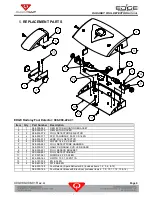
RADARAY FOUL DETECTOR MANUAL
400-088-006-01 Rev. A
Page 3
1.
GENERAL INFORMATION
This manual describes the installation, alignment, and operation of the QubicaAMF EDGE Radaray
Foul Detector, part number 088-000-222-01. This manual also contains information on maintaining the
unit and provides a list of replacement parts.
The EDGE Radaray provides a means of detecting encroachment upon the foul line on a pair of
lanes. The unit employs two (2) retro-reflective photoeyes. All that is required externally are reflectors
mounted across the lanes from the Radaray unit. The EDGE Radaray is designed to be used only
with the EDGE Free Fall Pinspotter System Controller (Chassis).
The unit is powered by 12 VDC at 0.1 Ampere from the EDGE Free Fall System Controller. When a
foul is detected (the optical path between the unit and the external reflector is broken), an
independent signal for that lane is sent to the System Controller, telling it that a foul occurred. Also, a
sinking 12 VDC signal is activated for 12 seconds which lights the LED for that lane (mounted in the
control unit cover) and causes a beeper to sound for approximately 13 seconds.
2.
INSTALLATION AND ALIGNMENT PROCEDURE
Reflector Assembly
The reflector unit mounts at the end of the common lane division capping. The unit should be
positioned so that the center of the reflector is in line with the approach edge of the foul line. The
installation sequence is as follows:
1. Assemble the reflector base and cover (without the reflectors) and secure together with the 1/4-20
x ½” machine screws provided.
2. Position the assembly on the common lane division, aligning the center of the cutout in the side of
the cover with the approach edge of the foul line. Using a felt-tip pen, make a mark on the division
and extend it onto the metal base in the center of the cutout.
3. Remove the cover from the base and position the base on the division so that the mark on its side
aligns with the mark on the division.
4. Mark the location of the two mounting holes using the base as a template, then drill pilot holes as
necessary for the two mounting screws. A typical pilot hole should be 5/32" in diameter.
5. Secure the reflector base with the two self-tapping #10 x 1" hex head screws.
6. Install the reflectors and cover using the two 1/4-20 x ½” machine screws.



































